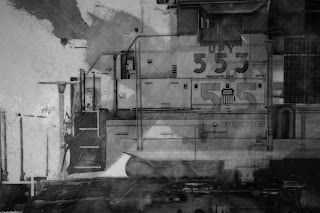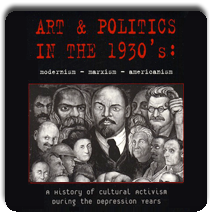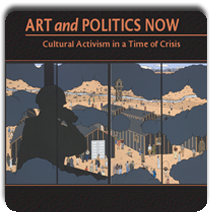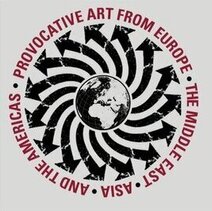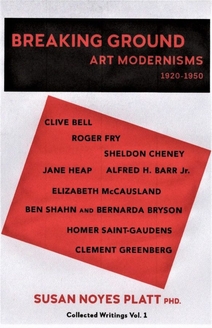Roger Shimomura and other shows
The Roger Shimomura show “Yellow Terror” at the Wing Luke Museum is a rare opportunity to see the artists collections of racist kitsch juxtaposed to his paintings. The kitsch collections have been given to the Wing Luke Museum, but the really urgent reason to go to the show several times is to see the way he brilliantly uses these racist stereotypes in his art. He barely transforms them, except in scale. We can hardly believe how well he does it.
Yellow Terror, the title piece of the exhibition- this is a detail- is a dizzying array of World War II “Japs,” crammed against each other, flying through the air, climbing on top of each other At the center is the artist himself calmly self caricaturing himself in the midst of the mass of caricatures. The caricatures sources are all on display next to the paintings, and unbelievably, we find ourselves laughing at Shimomura’s humor, at the same time that we know he is deadly serious. Racist stereotyping is so awful, it is hard to believe.

As in Different Citizens, 2009, above, a self portrait next to a Japanese stereotype This is a large painting,three feet by almost four feet. There is Roger on the right, he is an understated quiet person, a distinguished professor. There is the stereotype, the big ears, slanted eyes, big mouth, buck teeth, and the officer on the left.
But the point here is not old/new, The point is that the World War II stereotypes are still with us. Everyday, everywhere. That is why he has included a collection of salt and pepper shakers. Racism with your salt. It permeates, it sits there. The salt and pepper shakers are passive little stereotype”Orientals” in ethnic clothes, waiting to be picked up by larger powers!
Even at the opening, he pointed out an account of a new racist film The Goods, Live Hard Sell Hard” which has a mob beating up a Japanese American. Nothing has really changed except the surface..

Roger’s artistic facility with different vocabularies is also astonishingAs seen in the other painting here, American Portrait no 2, 2002, Shimomura can play with traditional Japanese images, Walt Disney cartoon types, Marvel superhero comics, formalist principles, and all arranged in amazing compositions that are far more complex than they appear to be. This composition with its boxes within boxes and the idea of a may different types of stereotypes juxtaposed to the Kabuki actor playing a warrior from Ukiyo e prints ( is this an “authentic” stereotype?), is all by itself worth a long analysis.I highly recommend Jen Graves article in the Stranger as a great review.
On the subject of opposing racism, a different perspective is offered by the James Washington House exhibition of artists who have had residencies there which is currently on view at the Pratt Gallery. The opening itself was a delight. Tim Detweiller has brilliantly brought together a wonderful mix of artists from different backgrounds, all of them making provocative work inspired by the studio and left -behind materials of the sculptor James Washington. In this installation shot you see Joe Max Emmenger well- known Seattle artist next to Charles Parrish work known only to some communities.
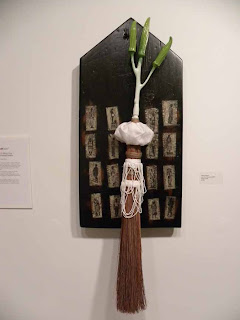 This is Daniel Minter’s work New Path Revealed. It is a subtle work, a broom, with beading and a silk shower cap like top that becomes a ceramic okra plant. In the background are prints of various African American figures in traditional types of work.
This is Daniel Minter’s work New Path Revealed. It is a subtle work, a broom, with beading and a silk shower cap like top that becomes a ceramic okra plant. In the background are prints of various African American figures in traditional types of work.
 Then there is the wooden sculpture by Romson Bustillo called A spell to remember or forget. Bustillo is a brilliant artist and community activist. He is from Mindanao, Philippines. He draws on abstract patterns from textiles here, and other sources to create evocative pieces that contain magical energy.
Then there is the wooden sculpture by Romson Bustillo called A spell to remember or forget. Bustillo is a brilliant artist and community activist. He is from Mindanao, Philippines. He draws on abstract patterns from textiles here, and other sources to create evocative pieces that contain magical energy.
 Esther Ervin’s Pipe Dreams is self contained, elegant, and dreamlike. Ervin is an artist with a subtle sensuality that plays out in different media. At the James Washington House she worked with the wax thread on spools from old recording devices.
Esther Ervin’s Pipe Dreams is self contained, elegant, and dreamlike. Ervin is an artist with a subtle sensuality that plays out in different media. At the James Washington House she worked with the wax thread on spools from old recording devices.
Other artists in the exhibition included Marita Dingus, and Jite Agbro, but I am out of time for now.
The point is that each of these artists is approaching the inspiration of James Washington from their own perspectives and different backgrounds. And the opening was a truly mixed group of artists and audience. Bravo James Washington Foundation.
This entry was posted on November 7, 2009 and is filed under Esther Ervin, James Washington Foundation, Joe Max Emminger, Roger Shimomura, Romson Bustillo.
Bumbershoot How Times Change
I am finishing my book, so my blog has taken a back seat, but I must write a quick note about Seattle’s art festival Bumbershoot 09. I have loved going to this arts festival since I moved to Seattle in 1998. But it certainly has changed. It used to be full of informal creativity, clowns, the amazing spoon man, acrobats, magicians, simply moving through the festival. There was an entire paviilion for publishers and literary readings lasted all weekend.
Now we have high tech spectacles like Flexion by Wise Fool of New Mexico ( muscle acrobatics) and Rockstar Energy Drink Vert Ramp ( skateboarding ). They were big machines . Man and Machine. Also there were lots of other techie booths. The arts and crafts which used to be a highlight have declined dramatically. A few survivors include my favorite hat store, but most of them are not too interesting. That is probably because of the increased cost of a booth has shut out all but rich people, and people who sell well are usually less aesthetic ( I shouldn’t generalize like that, but I can’t help the facts on the ground, the jewelry and clothing was less individually interesting to me).
Literary arts are now simply a few readers and a small display from the Unviersity Book Store. Granted the readers were in a big theater, but the numbers are small. And guess what they were all white people. Whoops. They were funny, talented and in some cases amazing, as in the case of Tara Hardy, who is really formidable. But is spoken word poetry a type of white rap??
The creative performances that I saw were terrific, but they were all really professional! Like Bach’s 40 Goldberg Variations performed entirely by heart by an amazing pianist named Francoise Papillon, accompanied by Mark Haim ( here is one dance) and assorted other dancers ( apparently Jerome Robbins did dances to Goldberg variations, but they costumes were not modern, Improvised Shakespeare, and Performance Space 122 from New York City.
Thank goodness for Greg Lundgren!. He brought back grass roots creativity with his Vital 5 projects. He believes that “our ability to communicate through art is what defines us as human” according to his web site.
He had people dressing up for photographs in random creative clothing, 
designing buildings in cut out paper 
and a documentation of a third project, making an art work in a shopping cart.  They were all in the context of his “Dada Economics” which is one of many projects that he pursues, in this case, random financial awards, that encourage ordinary people to be creative.
They were all in the context of his “Dada Economics” which is one of many projects that he pursues, in this case, random financial awards, that encourage ordinary people to be creative.
A puppet show

At the recommendation of a friend of mine, I went to see the Puppet Show at the Frye Art Museum. It came from the ICA in Philadelphia and co curated by the Vera List Center for Art and Politics at the New School. So naturally I expected something political. As usual when looking for politics in mainstream interpretations, I was deeply disappointed.
What an odd show, and an odd interpretation of the importance of puppets. The show had an historical segment, with no labels and no explanation at least in the Frye showing. I think maybe there are some labels in this picture from the ICA
Then it had a big room of hot contemporary artists that we are familiar with, lots of videos and sculpture.
The explanation for the broad inclusion of big name artists was that they “evoke topics associated with puppetry such as manipulation, miniaturization and control” OK, so you see where this is going. First we have a lack of historical information, then we have a focus on technique, rather than topic. Then the next sentence of the gallery blurb said “Perhaps it is the puppet’s power as an allegorical object that makes it so relevant and liberating.In a time when communication seems increasingly mediated and individual agency diminished, puppets abstract the drama, mysteries, anxieties and personas we might all project onto a shared stage.”
The key word here is “abstract”. That is of course not the point of puppets at all. It is perhaps the point of the contemporary art by Louise Bourgeois, Annette Messager, and other contemporary sculptures, but puppets are about politics, about speaking truth to power, about saying exactly what you think. They are not about miniaturization, but about creating a parallel universe that is very political. It can also be mythical, romantic, and historical, aesthetic, and really, really funny.
They also tell stories. Fun stories with second dark meanings. But none of those basic ideas are present in either the show or the gallery discussion.
In spite of all efforts to obfuscate and play the abstract card, there was some great work by William Kentridge including his seminal collaboration with The Handspring Puppet Company from 1994 in Johannesburg called”Ubu and the Truth Commission.” It was about the Truth and Reconcialition Commission. This was worth sitting through entirely.
The Survival Ressearch Laboratories also had an odd early piece of robots and lots of conflagration from the summer following the World Trade Center attacks. It seemed like a statement about contemporary society to me, but a little too Terminator and Hollywood.
There were some other videos like Kara Walker’s that I have seen before, with the usual Walker issue. Does it perpetuate racist stereotypes, or offer horrifying revelations of sexual assualt during slavery. An article in recent analysis I have read suggested that Walker needed to see a therapist.
And of course the main idea of a puppet being manipulated by some higher power is always something to think about, except for us activists, who want to get people moving, not have the idea that we are all pawns in a bigger picture where we are not holding the strings.
But puppets are really political, they are not games, they are not really passive. We pick up the controls ourselves, it is a populist art of resistance. That was missing of course.
Where was Bread and Puppet Theater for example.
What about puppet traditions like Karagoz that include both Turkey and Greece and which is full of ancient stories with modern resonance.
What about Indonesia where puppets are a central art form.
What about actually engaging with the history of puppets, rather than contemporary artists with name ID who really have nothing to do with it, or who do feeble spin offs from Sesame street(Christian Jankowski) that are more aggravating than important..
This entry was posted on August 7, 2009 and is filed under Puppet Show Frye Art Museum.
The contradiction of life and death

I am seared by the contradictions of life and death. On the one hand I have a beautiful new baby grandchild and a lovely 19month old grandson who is still innocent of the world, but expanding his skills everyday. On the other hand, I am living in a country that funds death and war as its first priority, cuts human services as the most dispensable government services, supports bankers at every opportunity. It stimulates the economy with road building and car buying. Where is the drastically new thinking that is necessary for all of our children’s and grandchildren’s futures????
To try to do something I am joining a lobbying campaign to try to convince our US representatives to stop funding death and destruction by Israel against the Palestinians. In the Gaza offensive there were massive violations of international law 13oo people killed, 5500 people injured, 4000 buildings destroyed. From January 2001 – November 2008 Israel killed 2086 Palestinian Citizens not taking part in hostilities. Of those 723 were children under 18.
And of course that is only one place that our tax dollars are killing people.
It is unbelievable that the US people are so inhumane, so stupid, so oblivious, that we go on spending billions and billions for killing human beings all over the planet. The birth of one human being is a miracle, the death of one human being by the murder that we call war is horrifying. But the level of our world wide killing and training for killing, as well as our torturing in prisons both in the US and elsewhere is psychotic. I have to accept that our smiling facade masks the soul of a serial killer.
So please join the campaign to End the Occupation campaign to talk to Congressman in August to call for a change in our policy. Join the campaign to sanction Israel. modelled on the plan to end Apartheid in South Africa.
There are also major efforts to activate artists to get involved with this campaign to inform people about Palestine. A recent article in the New York Times stated that Hamas is prioritizing culture over throwing bombs.
There is a campaign for artists to help end the occupation. 
Everything makes a difference.
This entry was posted on August 3, 2009 and is filed under End the Occupation, Sanction Israel.
New Grand Baby Eleanor with her mother and her father and her brother Max
 The complete miracle of new life is astounding. This is Eleanor at three hours old. Big brother Max is now 19 months. They seem to be getting along so far.
The complete miracle of new life is astounding. This is Eleanor at three hours old. Big brother Max is now 19 months. They seem to be getting along so far.
Vashon’s Gravel Pit: Artists Fight Back

 This is the cover and last image from Ann Leda Shapiro‘s beautiful small book about Vashon Island. She celebrates its natural beauties, its eccentric inhabitants, but she also calls attention to the dreadful gravel quarry on Maury Island.
This is the cover and last image from Ann Leda Shapiro‘s beautiful small book about Vashon Island. She celebrates its natural beauties, its eccentric inhabitants, but she also calls attention to the dreadful gravel quarry on Maury Island.
There are efforts to stop its expansion by the new Lands Commissioner, but it is an uphill battle. Historically Maury Island was a rich fishing ground for native groups. Today it is still a key spawning area for young salmon and eels, a primary source of food for some orcas, a delicate ecosystem that nourishes the entire Puget Sound. The gravel pit has already damaged it, it should be removed, not expanded. What is the gravel for ? a road, a tunnel, Oh! Can’t we get it? We HAVE to start thinking differently.
Backbone Campaign is running a one week environmental workshop called “Localize this!” to develop activist strategies to protes the expansion of the Maury Island gravel pit. ( Ideally it should be shut down. ) They have made giant puppets, orca trumpets made of recycled material, pvc pipe and plastic bottles
 that children can blow into to make whale sounds, and mosquitoes puppets
that children can blow into to make whale sounds, and mosquitoes puppets making reference to the mosquito fleet of boats that used to serve Vashon, as well as a giant puppet with a recycled Rumsfeld mask as a corporate greedy capitalist!
making reference to the mosquito fleet of boats that used to serve Vashon, as well as a giant puppet with a recycled Rumsfeld mask as a corporate greedy capitalist! 

The whale structure is seen here of bamboo. I got a glimpse of the art in progress.
Here is the finished whale, now called Morrie the Orca. 
They have an amazing artist named Chris Lutter of Puppet Farm Arts helping them create imagery. You can barely see him in the background, planning how to image the issue with a group of artists. Here he is holding a drawing of another puppet Count Bleed ya Dry, under construction.
They are also collaborating with The Ruckus Society, the well known activist group.
 Here Ruckus is training people to climb on a scaffolding in order to release a banner. In another place people were learning activist kayaking. They are being trained to go out on Puget sound to block the further development of the gravel pit. Here is a report posted on the Backbone website local paper and King 5 news.
Here Ruckus is training people to climb on a scaffolding in order to release a banner. In another place people were learning activist kayaking. They are being trained to go out on Puget sound to block the further development of the gravel pit. Here is a report posted on the Backbone website local paper and King 5 news. 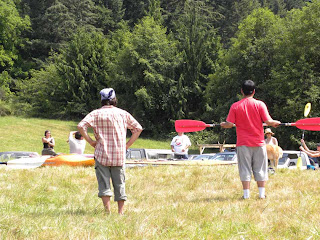 This is a great idea. Not just sports, but sports for a purpose. It can appeal to all those outdoorsy types who are politically liberal but don’t know how to get involved.
This is a great idea. Not just sports, but sports for a purpose. It can appeal to all those outdoorsy types who are politically liberal but don’t know how to get involved.
These type of collaborations with specific issues are exciting and effective.
Backbone created the Procession for the Future which went to 16 cities and conducted 8 workshops, providing activist material like freeway banners, puppets and silkscreens. A lot of the focus for Backbone ( Backbone for the Democratic Party that is) is environmental these days. Goodness knows, that is really crucial. They list on the video of the Procession for the Future, how much we could do to save the planet with all the money wasted on wars.
This anniversary of the Moon walk today, just makes it all the more obvious that we have a precious, special planet and we need to stop, stop, stop being fools about how we live here.
This entry was posted on July 16, 2009 and is filed under Ann Leda, Backbone Campaign, Maury Island, Puppet Farm Arts, The Ruckus Society, Vashon Island.
Seattle art and transportation
Last week I got out of my monastic isolation and thoroughly enjoyed First Thursday in Seattle. I talked with the folks at Revolution Books first, so I got an injection of hard core politics to set me up for the evening.They have a great show of photographs of the Winter Soldiers by Mike Hastie, not to miss either reading the book or seeing the photographs.
Then I went to The Monarch Gallery and met the director, Benito Rangel de Maria. I really like his complex train paintings, see detail above and he showed us his studio as well. He is focusing on Latina/o art in Seattle. Brave man. Tatiana Garmendia is coming up soon, a fabulous artist whose drawings about men at war are technically and conceptually riveting ( disclaimer I wrote her catalog).
see detail above and he showed us his studio as well. He is focusing on Latina/o art in Seattle. Brave man. Tatiana Garmendia is coming up soon, a fabulous artist whose drawings about men at war are technically and conceptually riveting ( disclaimer I wrote her catalog).
Then we ran in Elizabeth Bryant, a writer whom I greatly respect, and
a fun show of the work of Alice Wheeler at Greg Kucera’s
where I ran into Roger Shimomura.
His exhibition is opening at the Wing Luke in early September.
Then I went to The Monarch Gallery and met the director, Benito Rangel de Maria. I really like his complex train paintings,
 see detail above and he showed us his studio as well. He is focusing on Latina/o art in Seattle. Brave man. Tatiana Garmendia is coming up soon, a fabulous artist whose drawings about men at war are technically and conceptually riveting ( disclaimer I wrote her catalog).
see detail above and he showed us his studio as well. He is focusing on Latina/o art in Seattle. Brave man. Tatiana Garmendia is coming up soon, a fabulous artist whose drawings about men at war are technically and conceptually riveting ( disclaimer I wrote her catalog).Then we ran in Elizabeth Bryant, a writer whom I greatly respect, and
a fun show of the work of Alice Wheeler at Greg Kucera’s

where I ran into Roger Shimomura.

His exhibition is opening at the Wing Luke in early September.
We also stopped by the Pratt gallery and saw some great works made with recycled materials, although I wish Carletta Wilson had been included. Her works are dazzling.
Molly Norris has a show of her cartoons at Gallery 110. Funny and smart.
The second half of my title is not really on art and politics, but just a comment. Usually I devotedly and perseveringly ride the bus. Yesterday I had to do a lot of things in different places. The difference was dramatic. I saved hours of time, got to places in five minutes in stead of 60 minutes, no wonder no one with a schedule would ride the bus. But today, back on the bus, I realize how much I love seeing all kinds of interesting people, being part of a community, talking to people. It is an experience that is in the city. Riding my car I was in my little box, fighting with everyone else to stay alive. So the art in this half of the post is the art of people just living their lives and being human beings, rather than the sterile experience of freeways and their debilitating stress.
This entry was posted on July 8, 2009 and is filed under Benito Rangel de Maria Revolution Books, Molly Norris, Monarch Gallery.
John Feodorov’s Spiritual Ambiguities
 This piece Souls Awaiting a Future from John Feodorov’s recent show “Ambiguities” at South Seattle Community College Nat 18 – June 19, 2009 looks straightforward. The title tells what’s there. But actually, in the context of John Feodorov’s work it is both funny and subtle. The souls lying on the floor flat are wobbly, perhaps in some in between state of being. There is a celestial television projection, as well as stars hanging from wires. There seem to be four realities at least at work here, our own ( and what we bring to the work in terms of belief systems), the clay in betweens, the video of outer space, and the wires hanging form the ceiling with small stars at the end.
This piece Souls Awaiting a Future from John Feodorov’s recent show “Ambiguities” at South Seattle Community College Nat 18 – June 19, 2009 looks straightforward. The title tells what’s there. But actually, in the context of John Feodorov’s work it is both funny and subtle. The souls lying on the floor flat are wobbly, perhaps in some in between state of being. There is a celestial television projection, as well as stars hanging from wires. There seem to be four realities at least at work here, our own ( and what we bring to the work in terms of belief systems), the clay in betweens, the video of outer space, and the wires hanging form the ceiling with small stars at the end.
Feodorov questions our assumptions with humor and humility.
He was raised in Whittier California as the son of a fundamentalist. He travelled with his family to the Navajo Reservation to visit his grandparents and relatives. No wonder multiple realities are his focus.
He also has a particular riff in store for new agers, particularly those who borrow Indian elements for personal spiritual quests.
In his recent show in Bellingham he also showed disturbing pseudo spiritual installations
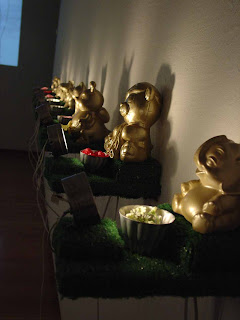
The South Seattle Community College show included a video called “We’re Feeding the Gods” dancers performing what appeared to be a type of ritual dance, but they are in a kitchen and other odd, random places, some of them pseudo beautiful. It is a real dance, but we can see that the context as it changes makes the dance seem pretentious and hollow. Perhaps that is John’s attitude to institutionalized religion as well as New Age practices.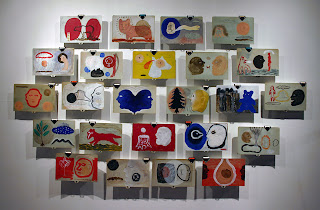 Also in the show is the Alphabet group of small works. Some have his characteristic puffy cheeked silhouette ( the artist ?) with various eccentric tableaux. The more you look, the more you wander off into some crazy land where nothing is quite as it seems.
Also in the show is the Alphabet group of small works. Some have his characteristic puffy cheeked silhouette ( the artist ?) with various eccentric tableaux. The more you look, the more you wander off into some crazy land where nothing is quite as it seems.
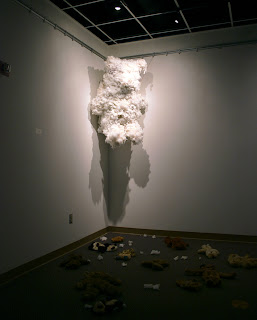
 Dominating everything is the teddy bears, a theme John has taken up before ( see an example of his Totem Teddy here) , early in his career. In this show at South Seattle Community College there are a lot of empty teddy bears on the ground and their stuffing has been put together as a giant teddy shaped apparition, as though the ghost of all discarded teddy bears is collectively haunting us, and lurking behind that ghost is the real bear, an heroic creature, outraged by this travesty of cuteness for his grandeur.
Dominating everything is the teddy bears, a theme John has taken up before ( see an example of his Totem Teddy here) , early in his career. In this show at South Seattle Community College there are a lot of empty teddy bears on the ground and their stuffing has been put together as a giant teddy shaped apparition, as though the ghost of all discarded teddy bears is collectively haunting us, and lurking behind that ghost is the real bear, an heroic creature, outraged by this travesty of cuteness for his grandeur.
Iran

 How can we think of anything else right now. The courageous uprising of the people of Iran, across class, religious, and both urban and rural ( although most demonstrations are in Tehran). The youth of Iran led protests in 2003, but now everyone has joined in. Their dignity, commitment, and bravery is formidable. As the traditional press are expelled, BBC commentator John Leynes was told to leave yesterday, we must all communicate about the new revolution in Iran. For that is what it is. The people are tired of the fraudulent politics, hypocritical religious posturing, and totalitarian oppressions. More links soon.
How can we think of anything else right now. The courageous uprising of the people of Iran, across class, religious, and both urban and rural ( although most demonstrations are in Tehran). The youth of Iran led protests in 2003, but now everyone has joined in. Their dignity, commitment, and bravery is formidable. As the traditional press are expelled, BBC commentator John Leynes was told to leave yesterday, we must all communicate about the new revolution in Iran. For that is what it is. The people are tired of the fraudulent politics, hypocritical religious posturing, and totalitarian oppressions. More links soon.
I couldn’t help compare the outpouring of focused and committed demands from the Iranian people to an event I went to in Seattle on Saturday night, in which exactly the same age group were freely expressing themselves, dancing, singing, painting, performing in a whirlwind of creative expression. But most of it didn’t have much substance or any point really, which was too bad.The only point was that they were being encouraged and supported in being randomly outside the box, as in a chorus of young women dressed as angels, men in lab coats climbing up the theater to the tune of trumpets ( I liked this piece), and a young man painting perfectly terrible paintings. I went because my amazing yoga teacher was performing, and he didn’t disappoint. He is a butoh dancer, and his range of expression with his body was astonishing. One felt the absolute disruption of facade and the revelation of the violence underneath in every human being simply through the expressions, body movements and gestures.
This is the freedom that the Iranian people are fighting for. The contrast couldn’t be greater, between the young people of Iran, focused, brave, insistent on their right to be free, and the freedoms taken for granted here by ( at the Moore) predominantly young white people.
These two posters by Lida Red bring together art and the uprising in Iran.
Shakespeare’s The Tempest Then and Now
 Ahh how perspectives change and yet trully insightful people all get it right in the first place. Shapekeare’s The Tempest, known as his “American Fable” currently being performed in Seattle by the Seattle Shakespeare Company, presents a contemporary perspective on the play as suggesting forgiveness. Yet this play only a few years ago was recognized as a parable of the earliest years of European colonization in the Americas. In 1609 the British were founding a colony in Virginia and England was excited. Shakespeare wrote this play using diaries by shipwrecked crews who landed in Bermuda and other primary sources.
Ahh how perspectives change and yet trully insightful people all get it right in the first place. Shapekeare’s The Tempest, known as his “American Fable” currently being performed in Seattle by the Seattle Shakespeare Company, presents a contemporary perspective on the play as suggesting forgiveness. Yet this play only a few years ago was recognized as a parable of the earliest years of European colonization in the Americas. In 1609 the British were founding a colony in Virginia and England was excited. Shakespeare wrote this play using diaries by shipwrecked crews who landed in Bermuda and other primary sources.
So the story is that of an Italian duke whose dukedom has been stolen by his brother while he was brooding over books. He has landed after a shipwreck on an isolated island, but one which had indigenous inhabitants, represented in the play by Caliban.
Here is what surprised me. In 1964 in his book Machine in the Garden, Technology and the Pastoral Ideal, based on ideas he developed in the late 1950s, Leo Marx referred to this play as An American Fable did a protracted analysis of it as a reference to European civilization taming nature, the contradiction of nature and culture, etc etc.
But when I saw it, I was astounded by Shakespeare’s acute understanding that Europeans were going to take over, destroy and enslave the Indians in their path. A speech by Caliban states just that. Of course his position as a”primitive” and “uncivilized” human being in the play echoes the dominant perspectives of Europeans in the seventeenth century ( and still really), but Caliban speaks eloquently of his love for his island, and the fact that after he showed the invadeing European around, the Duke enlsaved him. But Caliban’s eloquence in spite of his constant assault as a sub human being by the Europeans, suggests that in the early seventeenth century there was also awe and respect for Indinas. Indeed, they were perceived as independent kingdoms, and their leaders were often celebrated as fellow royalites in these early days of European contact.
Then more Europeans ( Stephano above with Caliban) land on the Island, the result of a storm that the Duke (Prospero) caused by his magical powers in order to bring his brother and fellow plotters there.
They also want to take over the island. They suggest taking Caliban back to England as a trophy, which is exactly what was happening then with people like Pocohontas, who died very young in England. An amazing portrait of her survives in Elizabethan clothing.
The new arrivals give alcohol to Caliban and he immediately becomes tamed and subject to their will ( another perceptive prediction on Shakespeare’s part, perhaps based on a reference in a contemporary diary about the susceptability of Indians to alcohol.)
But in the end the Europeans depart, back to “civiliation”.
The program of the Tempest said not one work about all this.
All we got was “forgiveness” and that forgiveness is not Caliban’s for his oppression, but the Duke for his brother’s perfidy. So much for the new age of post racism. Well, of course Shakespeare doesn’t exactly explain Caliban’s feelings at the end of the play. The ending is unlike Shakespeare except for the dramatic death of the senior Duke. Everyone else just seems to move on without any explanation.
The trappings are Shakespeare, but the content is radically different. Go see it!
This entry was posted on June 8, 2009 and is filed under indians, Leo Marx, Shakespeare The Tempest.



